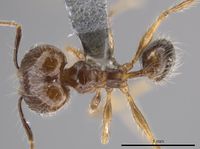Pheidole cataractae
| Pheidole cataractae | |
|---|---|

| |
| Scientific classification | |
| Kingdom: | Animalia |
| Phylum: | Arthropoda |
| Class: | Insecta |
| Order: | Hymenoptera |
| Family: | Formicidae |
| Subfamily: | Myrmicinae |
| Tribe: | Attini |
| Genus: | Pheidole |
| Species: | P. cataractae |
| Binomial name | |
| Pheidole cataractae Wheeler, W.M., 1916 | |
Nests in pieces of rotting dead wood on the floor of rainforest. A media (minor-major intercaste) was found in the Peruvian series. Having studied a colony I collected north of Manaus and maintained in the laboratory, I agree with the following assessment by Stefan Cover (personal communication), based on his experiences at Cuzco Amazónico: “P. cataractae belongs to a small guild of rainforest Pheidole characterized by agile, fast-moving workers and soldiers [majors] with relatively long appendages; it nests in ephemeral sites on the forest floor and finds food sources rapidly, but retreats if competition shows up.” The adaptation represents a behavioral (and in long appendages, anatomical) convergence to many species of the formicine genus Paratrechina. (Wilson 2003)
Identification
See the description in the nomenclature section.
Keys including this Species
Distribution
Known from one locality each in Guyana, north of Manaus in Brazil, and Cuzco Amazónico, near Puerto Maldonado, Madre de Dios, Peru. (Wilson 2003)
Latitudinal Distribution Pattern
Latitudinal Range: 5.665549° to -14.79861111°.
| North Temperate |
North Subtropical |
Tropical | South Subtropical |
South Temperate |
- Source: AntMaps
Distribution based on Regional Taxon Lists
Neotropical Region: Brazil, Guyana (type locality), Peru.
Distribution based on AntMaps
Distribution based on AntWeb specimens
Check data from AntWeb
Countries Occupied
| Number of countries occupied by this species based on AntWiki Regional Taxon Lists. In general, fewer countries occupied indicates a narrower range, while more countries indicates a more widespread species. |

|
Estimated Abundance
| Relative abundance based on number of AntMaps records per species (this species within the purple bar). Fewer records (to the left) indicates a less abundant/encountered species while more records (to the right) indicates more abundant/encountered species. |

|
Biology
Castes
Worker
Minor
Images from AntWeb
   
| |
| Worker. Specimen code usnment00691422. Photographer M. Pierce, uploaded by University of Utah. | Owned by USNM. |
Nomenclature
The following information is derived from Barry Bolton's Online Catalogue of the Ants of the World.
- cataractae. Pheidole cataractae Wheeler, W.M. 1916c: 6 (s.w.) GUYANA. See also: Wilson, 2003: 178.
Unless otherwise noted the text for the remainder of this section is reported from the publication that includes the original description.
Description
From Wilson (2003): A brown, unusually small and slender member of the diligens group.
Major: body mostly smooth and shiny, with portions of mesosoma and propodeum foveolate, and with widely spaced longitudinal carinulae over part of dorsal head surface, their interspaces foveolate or smooth and shiny.
Minor: very slender; propodeal spines reduced to denticles. A media, possibly a developmental anomaly, was found in a series from Cuzco Amazónico, in Amazonian Peru. Close to Pheidole calimana, distinguished from that species by its well-developed propodeal spines and shorter cephalic carinulae in the major and smooth, shiny head in the minor.
MEASUREMENTS (mm) Lectotype major: HW 0.94, HL 0.94, SL 0.76, EL 0.14, PW 0.44. Paralectotype minor: HW 0.42, HL 0.50, SL 0.64, EL 0.10, PW 0.28.
COLOR Major: body medium brown, with mandibles and anterior quarter of head capsule dark yellowish brown; antennae and legs medium yellowish brown.
Minor: body concolorous light brown, appendages a lighter shade of yellowish brown.
Figure. Upper: lectotype, major. Lower: paralectotype, minor, on top; and head, mesosoma, and waist, a minor from Fazenda Dimona, 90 km north of Manaus, Brazil, col. E. O. Wilson. Scale bars = 1 mm.
Type Material
Kaieteur, Guyana. Museum of Comparative Zoology - as reported in Wilson (2003)
Etymology
Gr cataract, waterfall, alluding to the Kaieteur Fall, at the type locality. (Wilson 2003)
References
- Wilson, E. O. 2003. Pheidole in the New World: A dominant, hyperdiverse ant genus. Harvard University Press, Cambridge, MA. (page 178, fig. major, minor described)
- Albuquerque, E., Prado, L., Andrade-Silva, J., Siqueira, E., Sampaio, K., Alves, D., Brandão, C., Andrade, P., Feitosa, R., Koch, E., Delabie, J., Fernandes, I., Baccaro, F., Souza, J., Almeida, R., Silva, R. 2021. Ants of the State of Pará, Brazil: a historical and comprehensive dataset of a key biodiversity hotspot in the Amazon Basin. Zootaxa 5001, 1–83 (doi:10.11646/zootaxa.5001.1.1).
- Franco, W., Ladino, N., Delabie, J.H.C., Dejean, A., Orivel, J., Fichaux, M., Groc, S., Leponce, M., Feitosa, R.M. 2019. First checklist of the ants (Hymenoptera: Formicidae) of French Guiana. Zootaxa 4674, 509–543 (doi:10.11646/zootaxa.4674.5.2).
- Wheeler, W. M. 1916c. Ants collected in British Guiana by the expedition of the American Museum of Natural History during 1911. Bull. Am. Mus. Nat. Hist. 35: 1-14 (page 6, soldier, worker described)
References based on Global Ant Biodiversity Informatics
- Bezdeckova K., P. Bedecka, and I. Machar. 2015. A checklist of the ants (Hymenoptera: Formicidae) of Peru. Zootaxa 4020 (1): 101–133.
- Delabie J. H. C., and I. C. do Nascimento. 1998. As Formigas do municipio de Ilhéus (Insecta: Hymenoptera: Formicidae). Especiaria 1(2): 133-152.
- Fernández, F. and S. Sendoya. 2004. Lista de las hormigas neotropicales. Biota Colombiana Volume 5, Number 1.
- Franco W., N. Ladino, J. H. C. Delabie, A. Dejean, J. Orivel, M. Fichaux, S. Groc, M. Leponce, and R. M. Feitosa. 2019. First checklist of the ants (Hymenoptera: Formicidae) of French Guiana. Zootaxa 4674(5): 509-543.
- Wheeler W. M. 1916. Ants collected in British Guiana by the expedition of the American Museum of Natural History during 1911. Bulletin of the American Museum of Natural History 35: 1-14.


